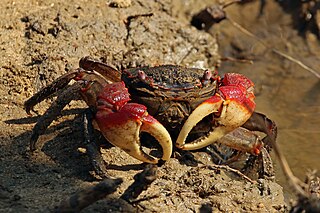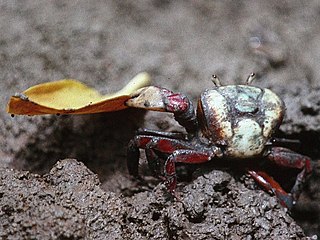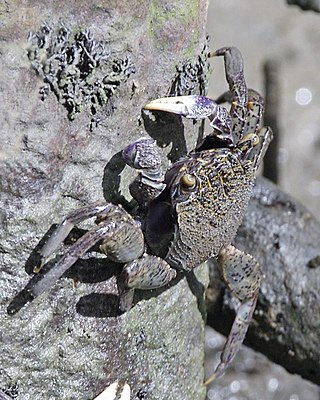
The Pacific gull is a very large gull, native to the coasts of Australia. It is moderately common between Carnarvon in the west, and Sydney in the east, although it has become scarce in some parts of the south-east, as a result of competition from the kelp gull, which has "self-introduced" since the 1940s.

Mangrove crabs are crabs that live in and around mangroves. They belong to many different species and families and have been shown to be ecologically significant by burying and consuming leaf litter. Mangrove crabs have a variety of phylogenies because mangrove crab is an umbrella term that encompasses many species of crabs. Two of the most common families are sesarmid and fiddler crabs. They are omnivorous and are predated on by a variety of mammals and fish. They are distributed widely throughout the globe on coasts where mangroves are located. Mangrove crabs have wide variety of ecological and biogeochemical impacts due to the biofilms that live in symbiosis with them as well as their burrowing habits. Like many other crustaceans, they are also a human food source and have been impacted by humans as well as climate change.

The little blue heron is a small heron of the genus Egretta. It is a small, darkly colored heron with a two-toned bill. Juveniles are entirely white, bearing resemblance to the snowy egret. During the breeding season, adults develop different coloration on the head, legs, and feet.

The crab-eating raccoon, southern raccoon, or South American raccoon is a species of raccoon native to marshy and jungle areas of Central and South America. It is found from Costa Rica south through most areas of South America east of the Andes down to northern Argentina and Uruguay. Despite its name, this species does not feed exclusively on crabs, and the common raccoon also seeks and eats crabs where they are available. In the Tupi–Guarani languages, it is known as aguará or agoará popé.

Mangrove forests, also called mangrove swamps, mangrove thickets or mangals, are productive wetlands that occur in coastal intertidal zones. Mangrove forests grow mainly at tropical and subtropical latitudes because mangrove trees cannot withstand freezing temperatures. There are about 80 different species of mangroves, all of which grow in areas with low-oxygen soil, where slow-moving waters allow fine sediments to accumulate.

Rhizophora mangle, also known as the red mangrove, is a salt-tolerant, small-to-medium sized evergreen tree restricted to coastal, estuarine ecosystems along the southern portions of North America, the Caribbean as well as Central America and tropical West Africa. Its viviparous "seeds", in actuality called propagules, become fully mature plants before dropping off the parent tree. These are dispersed by water until eventually embedding in the shallows.

The rufous crab hawk or rufous crab-hawk, is a Near Threatened species of bird of prey in subfamily Accipitrinae, the "true" hawks, of family Accipitridae. It is found on Trinidad and along the South American coastline from eastern Venezuela to southern Brazil.

The San Blas jay is a species of bird in the family Corvidae. It is endemic to Mexico where its natural habitat is subtropical or tropical dry forests; it is a common species and has been rated as "least concern" by the IUCN.

Dactylocnemis pacificus, the Pacific gecko or Pacific sticky-toed gecko, is a species in the family Gekkonidae, endemic to the North Island and offshore islands of New Zealand. D. pacificus is the only described species in the genus Dactylocnemis, but five offshore island forms may represent new species, one of which is the Mokohinau gecko.

An omnivore is an animal that regularly consumes significant quantities of both plant and animal matter. Obtaining energy and nutrients from plant and animal matter, omnivores digest carbohydrates, protein, fat, and fiber, and metabolize the nutrients and energy of the sources absorbed. Often, they have the ability to incorporate food sources such as algae, fungi, and bacteria into their diet.

Ucides cordatus, the swamp ghost crab, is one of two species of crabs in the genus Ucides. This species of crab is native to many coasts off of the western Atlantic Ocean. It has been found to be native to areas as far as Florida, to as southern as Uruguay. U. cordatus is especially noteworthy in the country in Brazil as it plays important roles in the economy and food resources at Brazil’s Atlantic borders.

Petrolisthes armatus, the green porcelain crab, is a species of small porcelain crab in the family Porcellanidae. It is believed to be native to Brazil but has spread to other parts of the world. Populations in the south eastern part of the United States have increased dramatically and the species is considered to be an invasive species.

Parasesarma leptosoma, also known as the arboreal crab, is an arboreal, leaf-eating mangrove crab, from East and South Africa where it is found on Rhizophora mucronata and Bruguiera gymnorhiza, but not on Avicennia marina. It occupies an ecological niche similar to that of another sesarmid, Aratus pisonii, from the Americas.

The violet vinegar crab is a swimming crab species in the genus Episesarma. Distributed all over marine and brackish waters of Indo-West Pacific regions. It is harvested by many local fishermen for rich proteinaceous food.

The Marajó várzea (NT0138) is an ecoregion of seasonally and tidally flooded várzea forest in the Amazon biome. It covers a region of sedimentary islands and floodplains at the mouth of the Amazon that is flooded twice daily as the ocean tides push the river waters onto the land. The flooded forests provide food for a wide variety of fruit-eating fish, aquatic mammals, birds and other fauna. It has no protected areas and is threatened by cattle and water-buffalo ranching, logging and fruit plantations.

Haberma tingkok is a species of micro-mangrove crab native to Hong Kong. It was first discovered by Stefano Cannicci from the University of Hong Kong and Peter Ng from the University of Singapore in the Ting Kok Mangrove forests in the northeast of Hong Kong and listed on the World Register of Marine Species (WoRMS) in April 2017. It was the third species placed in the genus Haberma, which was described in 2002.

The Esmeraldas-Pacific Colombia mangroves (NT1409) is an ecoregion of mangrove forests along the Pacific coast of Colombia and Ecuador. It is threatened by human population growth, leading to over-exploitation for wood and clearance for farming and aquaculture.

Armases cinereum, also known as the squareback marsh crab or wharf crab, is a species of crab in the family Sesarmidae. The wharf crab is a small crab that is dark brown to muddy in color, which allows it to blend in with its usual surroundings. It is found on the Atlantic southeastern coast, down into the Gulf of Mexico. It is an omnivore and is prevalent in marshy coastal environments along the Southwestern Atlantic.
The Couma sea catfish, also known as the Pemecou sea catfish, is a species of catfish in the family Ariidae. It was described by Achille Valenciennes in 1840, originally under the genus Bagrus. It inhabits estuaries and rivers in Guyana, French Guiana, Suriname, Brazil, Trinidad and Tobago, and Venezuela. It reaches a maximum total length of 97 cm (38 in), more commonly reaching a TL of 50 cm (20 in). It reaches a maximum weight of 30 kg (66 lb). Its maximum known life expectancy is 5 years.

Aratus is a neotropical genus of tree-climbing mangrove crabs in the serarmid family. The genus was first described by Henri Milne-Edwards in 1853, by separating A. pisonii into its own monotypic genus. Aratus has a range spanning Baja California and Sonora, south to Peru along the east Pacific, and from Florida to Brazil in the west Atlantic. Though there has long been attempts to distinguish the Atlantic and Pacific populations of Aratus into separate taxa, it was not until 2014 that sufficient genetic and morphological evidence was collected for the Pacific population to be described as a distinct species.





















